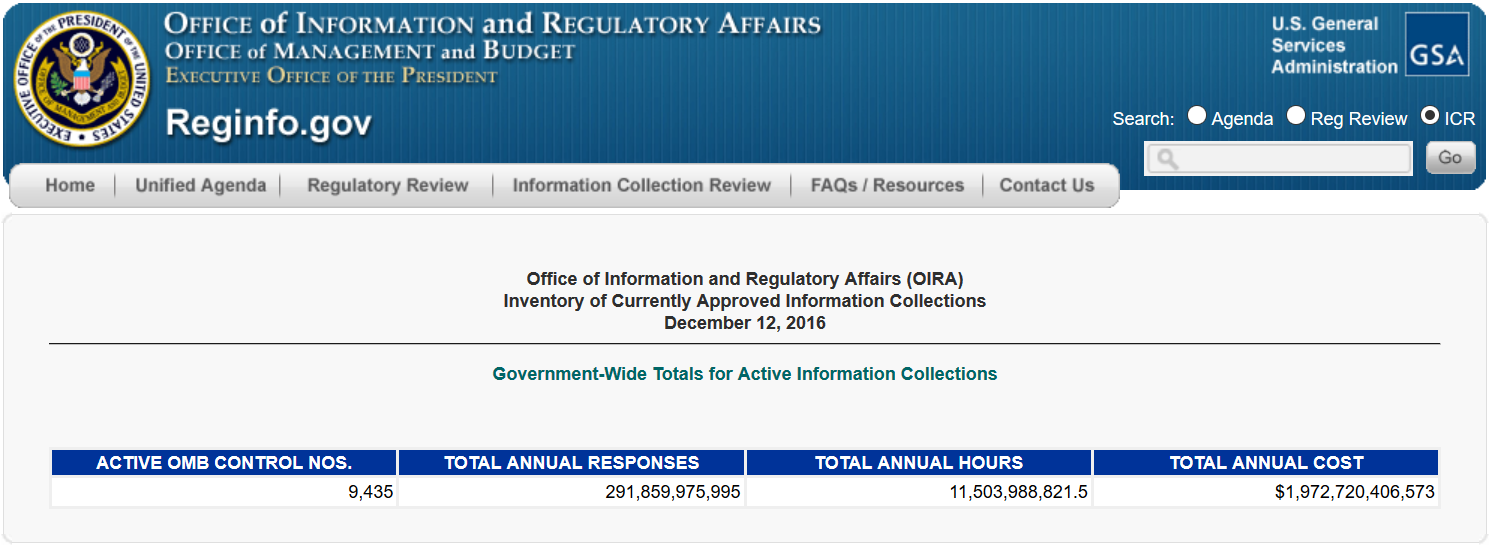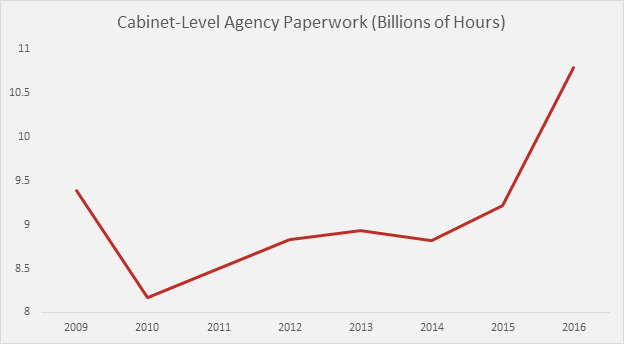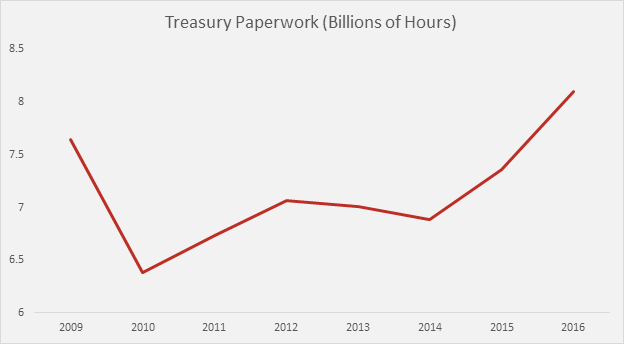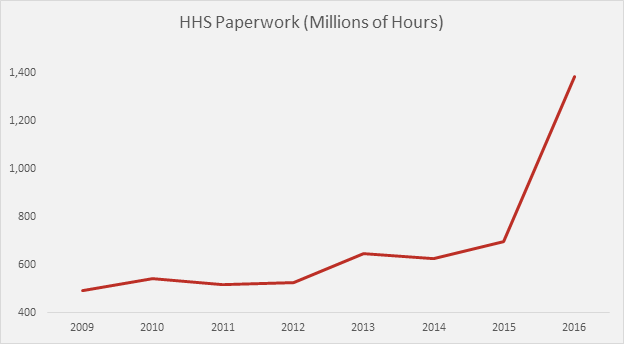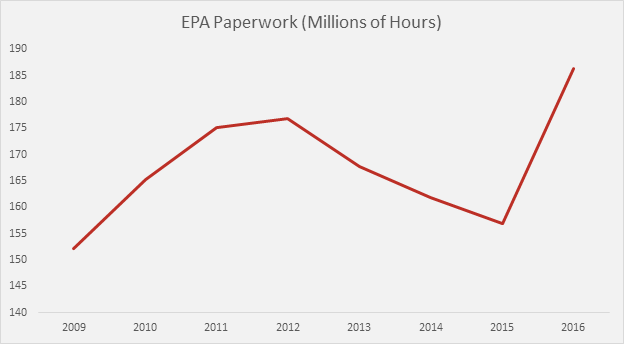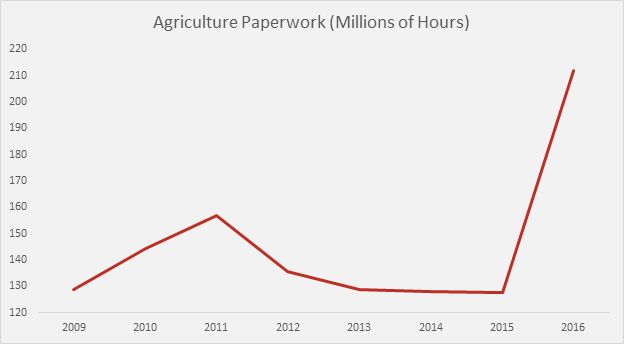Insight
December 20, 2016
Obama Administration Admits Paperwork Burdens at Record Levels
For the first time in more than two years, the administration released its count of the cumulative regulatory paperwork burden Americans must confront annually. Known as the “Information Collection Budget” (ICB), it includes a snapshot of the total paperwork burden, how that burden changed among agencies, and a list of agency violations of the Paperwork Reduction Act (PRA). Currently, the cumulative government-wide total is 11.5 billion hours, or 35 hours for every person in the U.S.
The most recent ICB, however, reports just 9.78 billion hours of paperwork during FY 2015, an increase of 350 million hours from 2014. Thus, from September 30, 2015 to today, the cumulative paperwork burden has jumped by 1.6 billion hours. To put this paperwork growth into context, it would take more than 800,000 employees working full-time (2,000 hours) to complete a year of these new reporting and recordkeeping requirements.
According to AAF’s daily tally of paperwork, the exact burden at the end of FY 2015 was 9.8 billion hours and the average during the fiscal year was 9.93 billion hours. However, Appendix C does note the additional burdens of other independent agencies, bringing the total burden to 9.8 billion hours. The ICB notes that previously, independent agencies like the Federal Reserve and the Consumer Financial Protection Bureau, were excluded from the report. Doing so omitted 87 million hours of paperwork, based on recent ICB projections. These additions explain the discrepancy between AAF’s daily tally and the ICB.
The chart below tracks the cabinet-agency paperwork burden during the Obama Administration.
Note, with the exception of 2010, when the administration didn’t remove hundreds of paperwork requirements, but reexamined the estimates of some of the major collections of information, the aggregate burden has been increasing. From 2009 to present, administration paperwork went from 9.3 billion hours to 10.7 billion hours, an increase of 1.4 billion hours. This is the equivalent of adding another Department of Health and Human Services (HHS) (1.3 billion hours) to the nation’s regulatory tab.
Much of this growth can be attributed to the Department of Treasury. At 8 billion hours, largely from IRS regulations, whenever there is a large collection of information, Treasury’s rise will significantly increase the national total as well. The chart below displays Treasury’s growth during the Obama Administration.
From 7.6 billion hours in 2009 to roughly 8.1 billion hours today, Treasury is responsible for approximately 28 percent of the cumulative increase in regulation. Some of this stems from hourly revisions of tax compliance, but the Affordable Care Act (ACA) is also a culprit. According to the Office of Information and Regulatory Affairs, there are 21 paperwork requirements “related” to the ACA. Combined, these collections impose more than 90 million hours of paperwork. From a tax compliance perspective, that’s the equivalent of 45,000 Americans dedicated to the ACA from just Treasury paperwork.
The HHS has the largest role administering the ACA, and unsurprisingly, its regulatory burden has dramatically increased. The chart below demonstrates its recent spike.
The scale of the recent increase, from 2015 to 2016, largely masks the steady growth since passage of the ACA. In FY 2009, HHS imposed 494 million hours, good for second in the federal government. By FY 2015, that figure grew to nearly 700 million hours. After a series of sharp revisions, HHS now imposes more than 1.3 billion hours of paperwork, with 195 paperwork requirement related to the ACA. To put HHS’s burden in perspective, it now imposes more hours of reporting and recordkeeping than all other cabinet agencies combined, apart from the Treasury, the government-wide leader. Amazingly, HHS has 82 requirements that impose at least 10 million hours of paperwork.
The final leaders in paperwork might surprise some: EPA and the Department of Agriculture. EPA’s regulatory growth has received plenty of media attention and this is largely reflected in its paperwork budget. For comparison, the Bush Administration approved 29 major EPA rules. The Obama Administration increased that total to at least 46 major rules, an increase of 58 percent. EPA’s paperwork has kept pace, as the graph below demonstrates.
Despite a steady decline, the agency’s burden remains 22 percent higher than it was in FY 2009. The largest drivers of this growth result from a measure for agriculture worker protection. At 10.4 million hours, it is now the third largest requirement in EPA’s paperwork budget. What’s more, the costs of that rule actually exceeded the benefits.
The Department of Agriculture might not strike many as having a strictly regulatory problem. Critics will attack subsidies and general policy, but Agriculture doesn’t typically regulate in the same command-and-control manner of EPA or the Department of Labor. However, from the paperwork perspective, AAF recently found that Agriculture is second only to HHS in the number of federal forms, approximately 3,700. The chart below tracks the agency’s paperwork growth since 2009.
Once again, after some progress removing cumulative paperwork, the agency added more than 84 million hours of paperwork from FY 2015 to today. Paperwork and reporting related to Food Stamps has been a major driver of this growth. In 2007, Food Stamp paperwork consumed 23.6 million hours of time (from 286 million “responses”). Today, that figure stands at 118 million hours (from 658 million “responses”), an increase of more than 400 percent. There are other drivers to federal paperwork overall and Agriculture specifically, but adding nearly 100 million hours related to Food Stamps would likely surprise many observers.
Violations
The OMB reported 283 violations in the most recent fiscal year, an increase of 58 violations from the previous year, or a 25 percent increase. A violation consists of collecting information without OMB approval, a lapse in approval for a current collection, or a discontinuation of approval. In other words, these are federal agencies violating a federal law, the Paperwork Reduction Act. In FY 2015, there were 87 collections where private individuals or businesses submitted information without prior authorization from OMB.
The ICB ranks cabinet agencies on their compliance with the PRA. Four agencies made the “poor” list this year, with more than 25 violations in a fiscal year:
- Defense (59)
- Health and Human Services (49)
- Homeland Security (35)
- Internal Revenue Service (30)
Some on this list might be excused because they collect so much paperwork in general (HHS and IRS). However, the Department of Defense only has 197 active paperwork requirements, so in one fiscal year it violated the law on nearly 30 percent of its paperwork budget.
In addition, three agencies made 11 to 24 violations and were rated by OMB as, “needs improvement.”
- Agriculture (14)
- Treasury (but not IRS) (11)
- Veterans Affairs (11)
Again, this wasn’t the first report that detailed widespread violations of federal law. This is an annual occurrence and in general, there is no punishment on federal agencies for skirting established rules. However, if individuals or businesses were to violate the law, agencies would be able to prosecute, even for paperwork infractions. There has been legislation introduced to provide minor relief to small businesses, but it has not advanced on the floor of the House and Senate.
Administrative Budget
With President-elect Trump pledging to enact a form of a regulatory budget, the ICB offers one avenue to achieve that desired policy goal. Although the data is far from perfect, at least there is a basic accounting of recordkeeping and reporting requirements. The nation knows how many paperwork collections exist and have an idea of the cumulative number of hours Americans spend complying with that paperwork. This stands in contrast to the total economic cost and benefits of regulation. Although an economist could probably derive a number for cumulative burdens, a dozen other economists could arrive at sharply different figures.
A paperwork or administrative budget, might be one path, or the first step, toward achieving a regulatory budget. As Professor Marcus Peacock of the George Washington Regulatory Studies Center recently wrote, an administrative budget has already been adopted overseas, but there are obvious drawbacks to this approach. First, it only addresses a sliver of overall regulatory costs. Second, it could create perverse incentives for regulators. As Peacock writes, “Regulatory options that favor the disclosure of information in lieu of more stringent constraints [disclosure of ingredients v. banning them] can be much less economically disruptive and is preferred as a regulatory alternative.”
However, as AAF has detailed in the past, there are obvious benefits to a paperwork budget, including political. Canada has adopted a version and perverse incentives have yet to fully materialize. A paperwork version is also less politically-charged than removing entire regulatory programs. There are few defenders of “red tape,” or the rote reporting and recordkeeping associated with the regulatory state. In addition, starting with a paperwork budget could deliver some immediate tangible benefits, and in the regulatory world, benefits are rarely immediate.
For example, some initial gains could arrive from tax reform. If Congress is able to provide simplicity for the tax code, it could generate tremendous paperwork savings. Even a ten percent cut in the time it takes corporations and individuals to complete tax information could save more than 547 million hours of paperwork, or substantially more than the 350 million hours of cumulative paperwork added in FY 2015. This may seems like a gimmick, but even conservative estimates for hourly compliance would generate tens of billions of dollars in savings.
The Obama Administration made some strides on targeted paperwork reductions during the past eight years. For example, removing Country of Origin labeling will save Americans $1.8 billion; removing “no defect” reports for truck drivers is estimated to save 46 million hours of paperwork and updating pollution discharge reporting will save $23 million annually and nearly 200,000 burden hours. There is little reason a formal regulatory budget couldn’t build on these gains and achieve some tangible regulatory savings for the nation. It’s not perfect or comprehensive, but it’s a first step. In a reality where regulatory reform often fails, let’s not let perfect be the enemy of the good.
Conclusion
The ICB is perhaps the last regulatory report the administration will issue. In 2012, then-regulatory czar Cass Sunstein urged agencies to cut between 50,000 to two million hours of paperwork. That year, the nation’s average paperwork burden was 10.3 billion hours. Today, it stands at more than 11.5 billion. It’s clear that efforts to reduce cumulative burdens failed, but renewed leadership from the president and Congress in 2017 can modernize the regulatory state and deliver billions of dollars in benefits.










